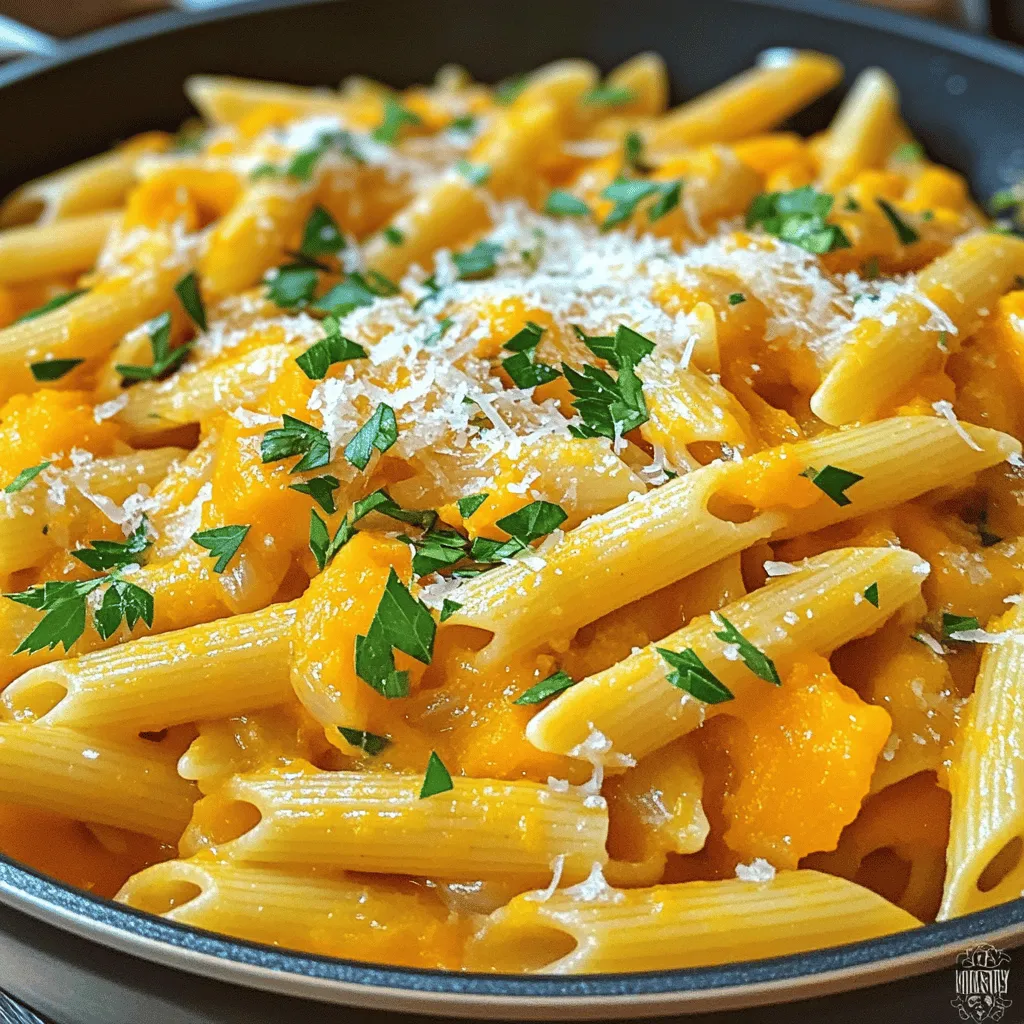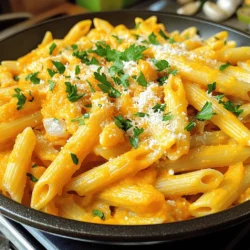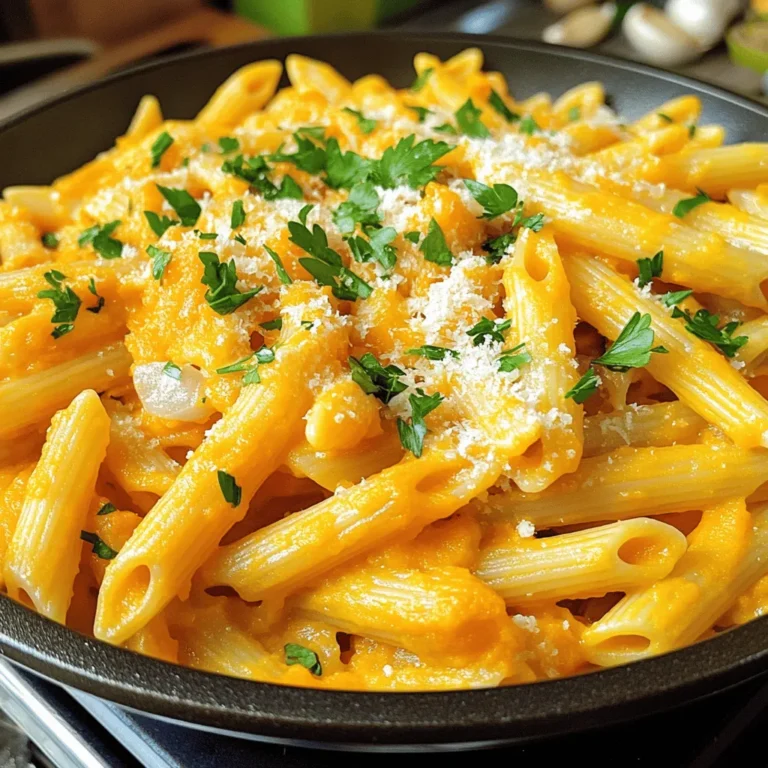Looking for a quick and tasty meal? Let me introduce you to the Butternut Squash Pasta Skillet! This dish combines creamy goodness with nutritious butternut squash, making it perfect for any night. Whether you’re a busy parent or just need a fast dinner idea, this skillet recipe is simple and satisfying. Plus, it’s packed with flavor and can be easily adapted to fit your diet. Let’s dive into the details!
Ingredients
List of Ingredients
– 12 oz penne pasta
– 2 cups butternut squash, peeled and diced
– 1 tablespoon olive oil
– 1 small onion, diced
– 2 cloves garlic, minced
– 1 teaspoon dried sage
– 1 teaspoon thyme
– 1 cup vegetable broth
– ½ cup cream cheese (or vegan cream cheese)
– Salt and pepper to taste
– ¼ cup grated Parmesan cheese (optional, for serving)
– Fresh parsley for garnish
For this butternut squash pasta skillet, you need fresh, quality ingredients. The penne pasta forms the base of the dish. I love using penne because its ridges hold the sauce well. The butternut squash gives a sweet flavor and creamy texture. You can also use pumpkin if you’d like.
The olive oil helps sauté the onion and garlic. It adds rich flavors that build the dish. I always choose a small onion for a more delicate taste. Garlic brings warmth and aroma to the meal.
Herbs like sage and thyme enhance the butternut squash’s natural sweetness. They also add depth to the flavor. Vegetable broth serves as the sauce’s base, bringing everything together. Cream cheese gives the sauce its creamy texture. If you want a vegan option, use vegan cream cheese.
Finally, salt and pepper add balance. Grated Parmesan is optional, but it adds a nice touch. Fresh parsley not only adds color but also a fresh taste. Keep these ingredients on hand, and you’ll whip up this quick meal in no time!
Step-by-Step Instructions
Cooking the Pasta
First, cook the penne pasta. Follow the package instructions to make it al dente. This means it should be firm but not hard. Once done, drain the pasta and set it aside. This step is key for a perfect texture in your dish.
Preparing the Skillet
Now, let’s prepare the skillet. Heat 1 tablespoon of olive oil in a large skillet over medium heat. Add the diced onion and cook it until it turns translucent, about 3 to 4 minutes. Then, add the minced garlic and cook for another minute until it smells great.
Next, stir in the diced butternut squash, dried sage, and thyme. Cook this mixture for about 5 to 7 minutes. Stir it occasionally. You want the squash to become tender but not mushy.
Creating the Sauce
Once your squash is tender, pour in 1 cup of vegetable broth. Bring this to a simmer. Cover the skillet and let it cook for about 10 minutes, or until the squash is soft. After that, use a fork or a potato masher to mash the squash slightly. This gives your sauce a creamy feel.
Now, add ½ cup of cream cheese to the skillet. Stir it until it melts and blends with the squash. If your sauce seems too thick, add a bit more vegetable broth until it’s just right.
Combining Ingredients
It’s time to combine everything. Toss the cooked penne pasta into the skillet with the butternut squash sauce. Mix well until the pasta is fully coated. Season your dish with salt and pepper to taste. Enjoy the tasty blend of flavors in this quick meal!
Tips & Tricks
Perfecting the Pasta
To cook pasta just right, follow these steps:
– Use a large pot with water.
– Add a pinch of salt to the water.
– Bring the water to a boil before adding pasta.
– Cook penne for 8-10 minutes until al dente.
– Stir occasionally to avoid sticking.
To avoid sticky pasta, make sure to:
– Rinse the pasta under cold water after draining.
– Toss it with a little olive oil.
– Add it to your sauce right away.
Enhancing Flavor
The best herbs to pair with butternut squash are:
– Sage, which adds a warm, earthy taste.
– Thyme, offering a light, fresh note.
You can add spice for extra flavor by:
– Mixing in a pinch of red pepper flakes.
– Using smoked paprika for a deeper taste.
Making it Creamier
For creamier options, consider:
– Using coconut milk for a dairy-free choice.
– Trying cashew cream for a nutty flavor.
Adjust sauce thickness by:
– Adding more vegetable broth if too thick.
– Stirring in extra cream cheese for a richer texture.

Variations
Vegan-Friendly Options
For a vegan-friendly twist, swap the cream cheese for a plant-based option. You can use vegan cream cheese or even cashew cream. Both will add creaminess without dairy. Try blending soaked cashews with a bit of water and lemon juice for a homemade version.
If you prefer gluten-free pasta, opt for substitutes like brown rice or chickpea pasta. These alternatives taste great and keep the dish light.
Additional Vegetables to Add
Feel free to add more veggies to your skillet! Spinach, kale, or bell peppers work well. You could even toss in some roasted Brussels sprouts for extra crunch. Seasonal veggies like zucchini or asparagus bring a fresh touch too.
Using vegetables that are in season makes your dish vibrant and tasty. Plus, it gives you a chance to experiment with flavors.
Protein Additions
Adding protein can make your meal heartier. For meat lovers, consider grilled chicken or shrimp. These can cook quickly in the skillet.
If you want plant-based protein, try beans or lentils. They mix well with the butternut squash and add great texture. For a quick option, stir in some canned chickpeas. They add protein and fiber, making the dish even more filling.
Storage Info
Refrigeration Guidelines
To store leftovers of your butternut squash pasta skillet, let it cool first. Then, place it in an airtight container. I recommend using glass or plastic containers that seal well. This keeps the flavors fresh.
Freezing Tips
If you want to freeze the dish, use freezer-safe containers. Make sure to leave some space at the top for expansion. To reheat, thaw it in the fridge overnight. Heat it on the stove or microwave until hot. Stir it well to mix the sauce back in.
Shelf Life Expectations
In the fridge, your butternut squash pasta skillet will last about 3 to 5 days. If you notice any off smells or mold, it’s best to throw it out. Always trust your senses when checking for spoilage.
FAQs
How do you make butternut squash pasta skillet?
To make this dish, follow these steps:
1. Cook 12 oz of penne pasta until al dente. Drain it and set aside.
2. In a large skillet, heat 1 tablespoon of olive oil over medium heat. Add 1 small diced onion and sauté for about 3-4 minutes until it’s clear.
3. Add 2 minced garlic cloves and cook for 1 more minute. You want it fragrant.
4. Stir in 2 cups of diced butternut squash, 1 teaspoon of dried sage, and 1 teaspoon of thyme. Cook for 5-7 minutes until the squash softens.
5. Pour in 1 cup of vegetable broth and let it simmer. Cover the skillet for about 10 minutes until the squash is soft.
6. Mash the squash slightly with a fork to make it creamy.
7. Mix in ½ cup of cream cheese until it melts. If the sauce is thick, add more broth.
8. Toss the cooked penne pasta into the skillet. Coat it well with the sauce.
9. Season with salt and pepper to taste.
10. Serve hot, topped with ¼ cup of grated Parmesan cheese and some fresh parsley.
Can I use other types of pasta?
Yes, you can use different pasta shapes. Bowtie, fusilli, or spaghetti all work well. Just make sure to adjust the cooking time according to package directions. The key is to cook pasta until it’s al dente, so it holds up well with the sauce.
Is butternut squash healthy?
Yes! Butternut squash is packed with nutrients. It is high in vitamins A and C, which support your immune system. It also has fiber, which helps digestion. Plus, it’s low in calories, making it a great choice for a healthy meal.
What can I substitute for cream cheese?
If you need a substitute for cream cheese, try using Greek yogurt or silken tofu for a vegan option. Both provide creaminess without losing flavor. You can also use a vegan cream cheese to keep it dairy-free.
Can I make this recipe ahead of time?
Absolutely! You can prepare the butternut squash sauce ahead. Just store it in the fridge for up to three days. When you are ready to eat, cook the pasta and mix it with the sauce. This saves time and makes meal prep easy.
This blog post shared a simple recipe for butternut squash pasta. You learned about the ingredients, cooking steps, and tips to make it perfect. It’s a great dish for all diets, including vegan. You can add your favorite veggies or protein for more flavor. Remember to store leftovers well so you can enjoy them later. Cooking doesn’t have to be hard. With this recipe, you can create a tasty meal easily. Enjoy the process and happy cooking!


